There are many different styles of hedgelaying throughout the British Isles. They have arisen for reasons of landscape, farming practice, and the species and vigour of the growth available in the hedge being maintained. This section contains descriptions of styles that can appear at the National Championship to help you spot the differences in what can be a confusing flurry of woodchip, chainsaw and animated hedgelayer.
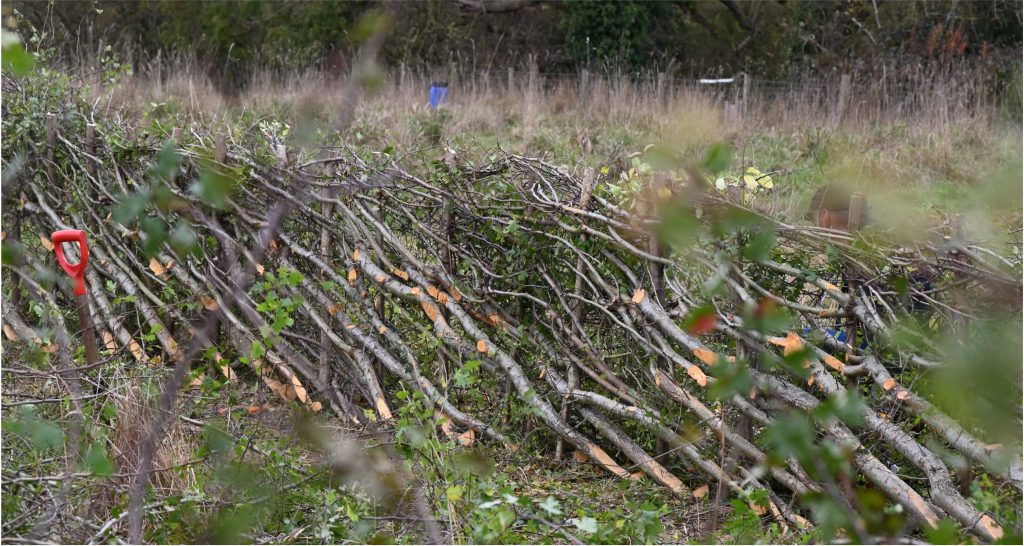
Cheshire
Cheshire style is designed to hold dairy cattle. It is 1 metre in height, laid 7cm off the stumps, with a long 45cm pleaching cut. The brush is left on the back of the hedge with a clean face on the front. The vertical hedge stakes are 50cm apart. There is no binding but string was traditionally used to tie the pleachers to the stakes and neaten the appearance by pulling in the narrow top of the finished hedge
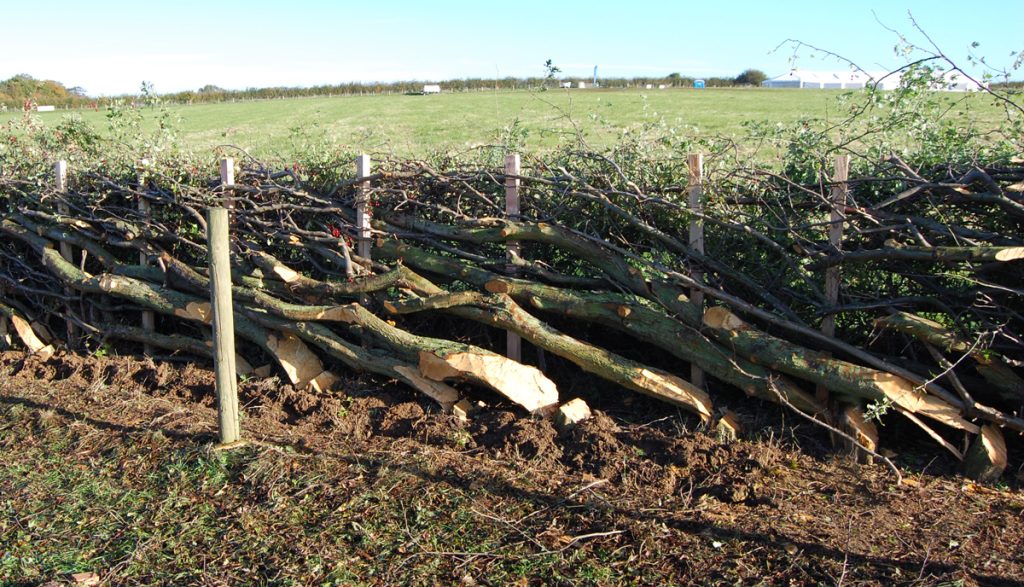
Derbyshire
Derbyshire style uses sawn timber or natural stakes which are placed 60–75cm apart and driven in vertically in a single row. Pleachers are woven both sides of the stakes and the brush is placed to the livestock side of the hedge. No binders are used on the stakes. The finished height of the hedge is 1–1.2m.
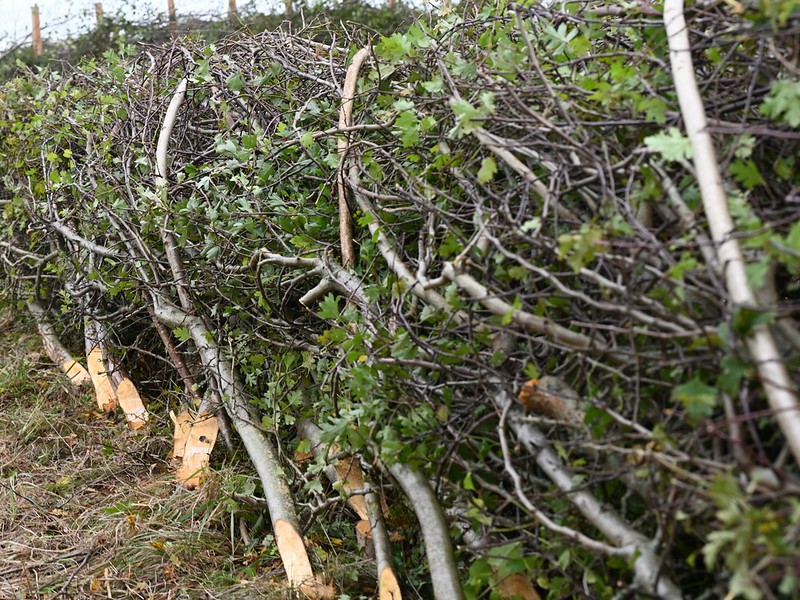
Dorset
Like Devon, the Dorset style hedge is normally laid on top of a bank. It is kept low to the ground, tightly woven in with itself. Thin flexible rods, cut from the hedge, called “bonds” are used to secure it both internally and by hooping over it externally if required. Occasionally crooks are also used. The finished hedge has a distinct half barrel shape and is about 80–90cm high.
Devon Style
Hedges in Devon are normally laid on top of a bank. The high earthwork and brashy top and sides together form the barrier to livestock. Unlike styles that use stakes for support, the pleachers are laid so they are almost horizontal and in contact with the ground. Where possible, they are laid to form two “combs” on either side of the top of the bank. After laying, the earth that has slumped from the bank is “cast up” to fill the gap between the combs. This encourages the pleachers to establish roots along their length and reinforce the bank. The densely packed brush and the now vertically sided bank is designed to keep sheep and lambs secure.
Pleachers are secured using tent-peg shaped “crooks” cut from the hedge and driven into the bank where needed. Uniquely in this competition, the crooks are provided by the competitors rather than the organisers. They are cut and shaped to personal preference and are very much part of the individual hedgelayer’s work signature.
Some areas of Wales use a similar style to Devon where their hedges are on banks. Cornish “hedges” are, by and large, a different matter. The word “hedge” being used to refer to stone faced banks which have little or no greenery on them. Cornish “hedgelaying” is more akin to dry stone walling in practise.
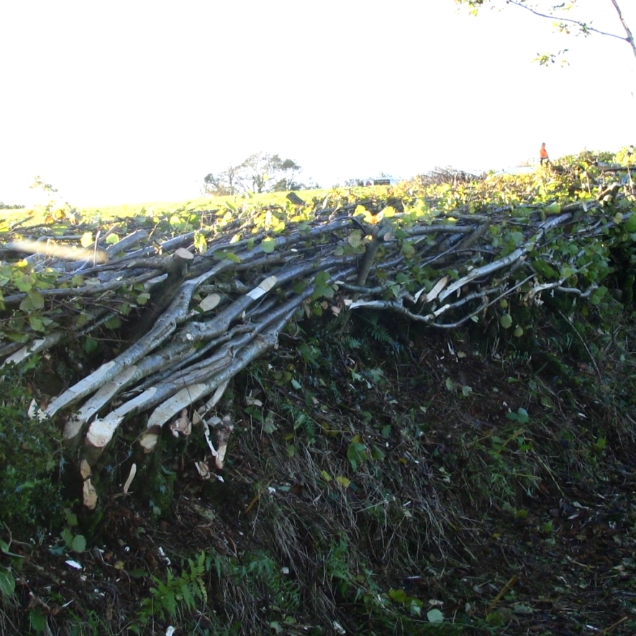
Lancashire and Westmorland
Lancashire & Westmorland hedges need to be well maintained for both cattle and sheep. Stakes are placed about 50cm apart on alternate sides and not above the top line of the hedge. The pleachers are laid between the stakes at an angle of 45°. The dimensions of the finished hedge are approximately 1m high by 70cm wide.
The pleachers are laid to both sides between the stakes with no crossing over. Brush is left on the outside to partially cover the stakes. To finish, the hedge is lightly trimmed , square in shape on top and sides. The centre of the hedge is sightly lighter than the rest of the hedge so that the regrowth from the stools can grow through without the shoots being nibbled by livestock – the style being designed to conceal the cut wood where the new shoots emerge.
Brush is evenly placed to both sides, from top to bottom with no gaps at the base.
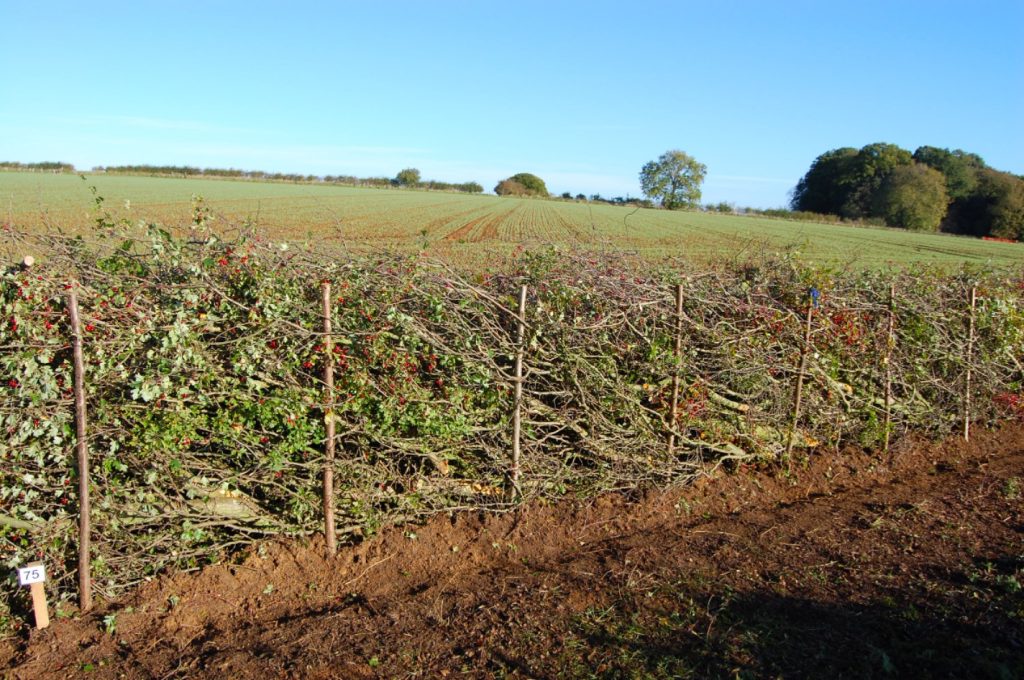
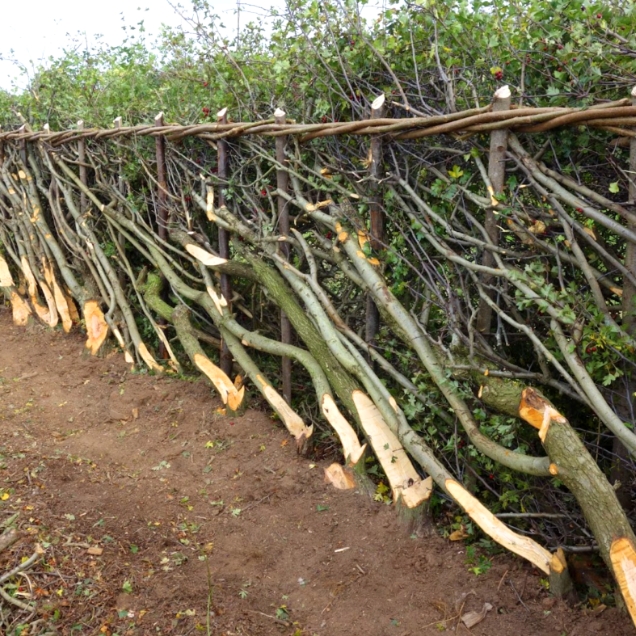
Midland style
The “Midland Bullock” hedge was created for farms with large animals, such as cattle and horses. It is able to withstand the weight of these animals pushing against it. It is the definitive style for the predominately thorn hedges found in the English Midlands. It is a “single brush” hedge meaning that the brushy growth is removed from one side to allow it to be laid.
The laid hedge is supported by stakes driven into the ground at 18″ intervals, behind the stem line towards the brush (bushy) side of the hedge. Hazel binders are woven along the top of the stakes to hold them in place and give maximum strength to the newly laid hedge. The finished hedge is 135cm high.
In the picture above, livestock would be in the field behind the far (brush) side of the hedge with a crop in the field nearest the camera. The hedge is laid slightly offset from the line of stems to encourage regrowth from the cut stools. This fresh growth will be used to build the hedge the next time it is laid.
It is worth a trip to view the far side of a laid Midland style hedge – when done properly, it is almost impossible to see that the hedge has undergone such a radical transformation at all.
Montgomeryshire style
A hedge from north Powys and over the border into Shropshire, suitable for sheep and arable fields.
Hedge height is usually 3 foot 6 inches (42cm), width 18 inches (45cm) to 2 feet (60cm) wide at the base. Classed as a double brush style. it has a brushy side known as the ‘face’ and a stronger stockproof side known as the ‘back’. The back is upright and the brushy side has a slope so when seen in section, the hedge is not symmetrical.
Usually stakes are 45cm apart and sloping backdown hill about 15cm back from upright…live crops also known as standers are living stakes which are tyopped off and are left along the hedge and must touch and hold pleachers in place.
There are no heathering’s in this style as the top of the hedge is made by adding long branches in behind one stake and around the next stake and the end of the branch goes through to the brushy side and is known as ‘plaiting. Dead wood can be added to fill any gap so a lamb cannot put his head in to the hedge.
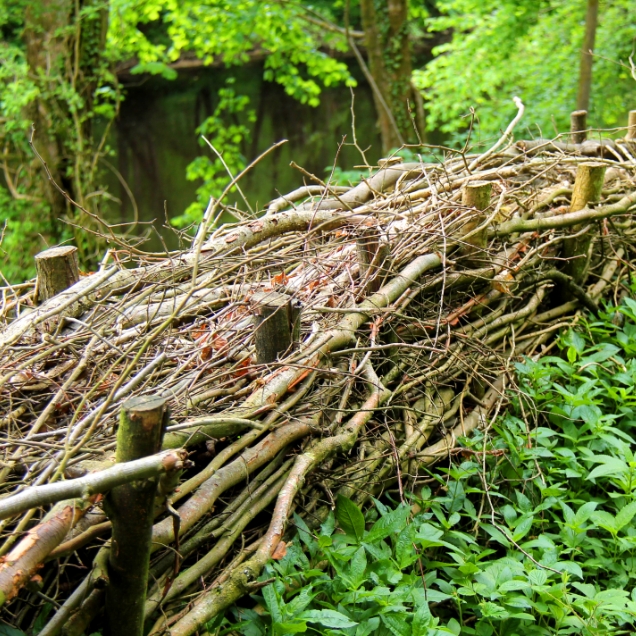
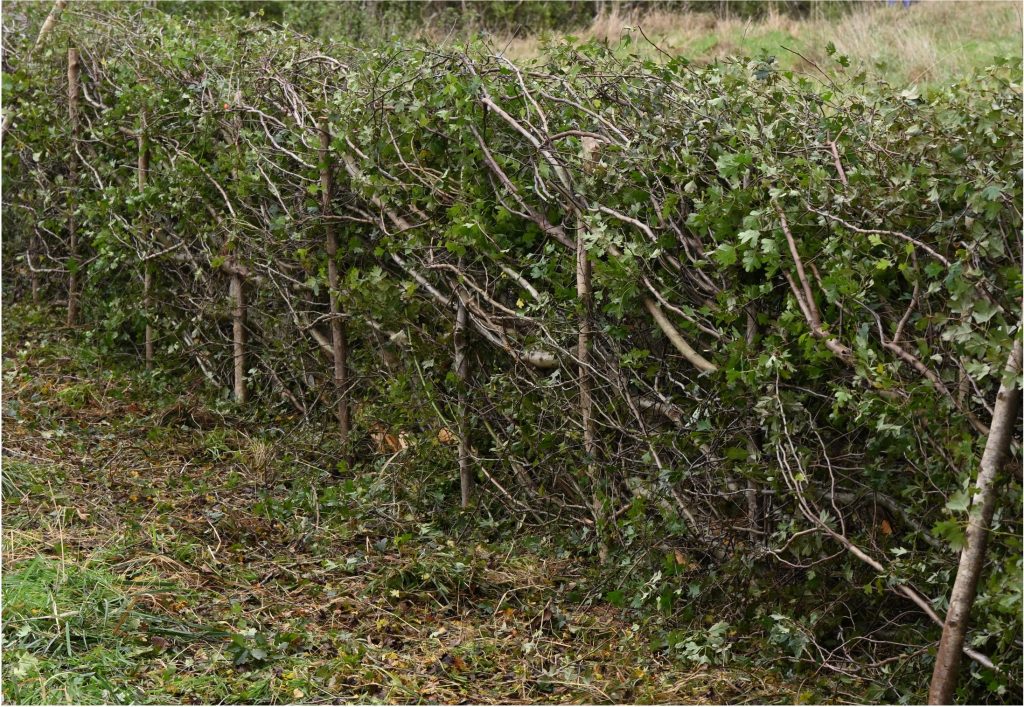
North Somerset Style
The North Somerset style of hedgelaying is practiced in a small area between Bristol and the Mendip Hills, centered on the villages of Wrington and Burrington, where the Hedging Society was founded in 1832. The area has old, mixed-species hedges, often on low banks with a ditch.
This style creates a low, dense hedge to contain cattle and sheep, with pleachers (“splashers”) held in place by side branch stubs. Stakes (“stavers” or “stabbers”) keep the hedge firm, forming parallel, staggered lines 90-120cm apart. The finished hedge is 45-60cm wide and 90-100cm high, trimmed neatly to encourage regrowth. It should be protected from livestock grazing for 1-2 years.
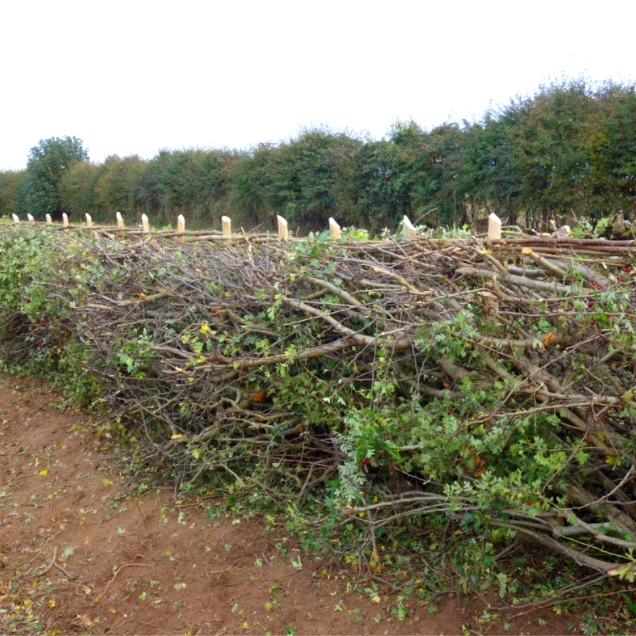
South of England Style
The South of England style is found predominantly in the South East of England. It is a strong ‘Double brush’ style which means that the brush (smaller, dense branches) are left on both sides of the finished hedge which can be between 80- 120cm wide. The brush should ideally fill each side of the hedge fully down to the ground, covering the base of the cut stems to stop animals being able to browse new growth in the following spring.
The stakes are placed in a single line 40-50cm apart in a straight line along the middle of the finished hedge. Unlike other styles the stakes are only placed in position after all the hedge has been laid down. Long hazel binders are woven between the stakes along the top of the hedge to hold everything tightly in place. The tops of the finished stakes are cut off with a slope facing directly along the centre line of the hedge. The sides are lightly trimmed into a box shape with the top of the brash being trimmed flat just under the height of the binders. The overall height of the finished hedge is usually around 120cm from the ground to the top of the binders.

Welsh border
There are numerous variants of the Welsh hedgelaying style from something akin to Devon “crooked down on a bank” in the south to a very “South of England” style in the borders.
To ensure a level playing field, the National Championship requires a “double brush” hedge (brash left on both sides) with natural or sawn timber stakes driven in 75cm apart at an angle of 35°, or sometimes closer – “so the rain dripping off the top of one, falls on to the base of the one next to it”. This sloping stake feature is a common trait of a lot of Welsh variants an unique to Welsh hedgelaying.
Pleachers are laid opposing the slant of the stakes. A significant amounts of dead wood is added to the hedge to protect the stools and regrowth from being grazed by the sheep the hedge is designed to contain. Binders may be used to secure the stakes down the centre line of the hedge and the top and sides of the hedge are trimmed. Today the hedges will be judged on a points basis but it is said that the true test of any Welsh style hedge is its ability “to stop a Welsh mountain ewe and two lambs in March”.
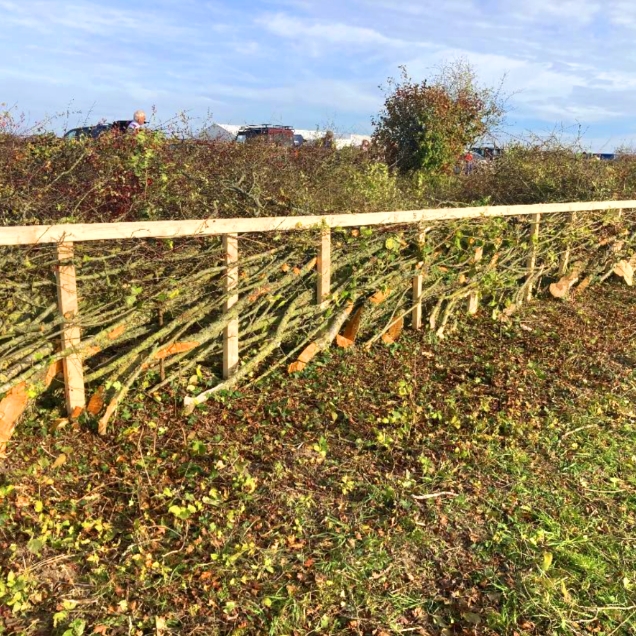
Yorkshire Style
The Yorkshire style has no brush on either side, with the stems laid directly over the stools. The stakes and top rail are sawn timber which is often made from sawmill slab wood. The rail is secured to the stakes and holds the pleachers down. The stakes are at varying distances, between the stools and are placed where the stems allow. The hedge isn’t intended to be stockproof for a couple of years, and is laid as part of an arable rotation.
